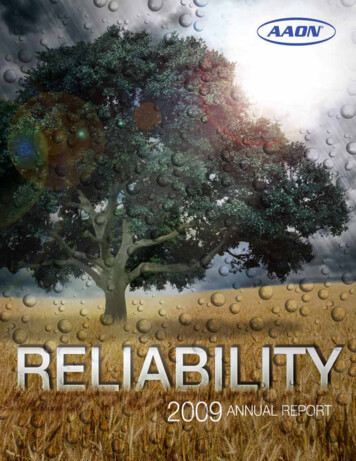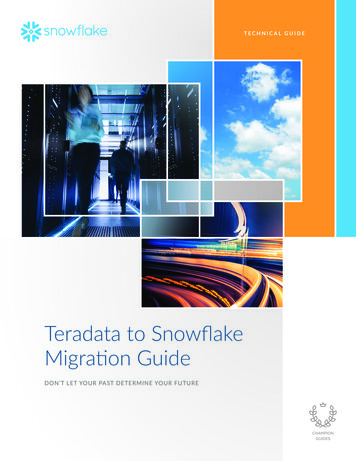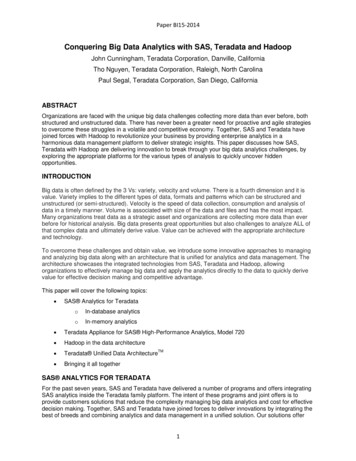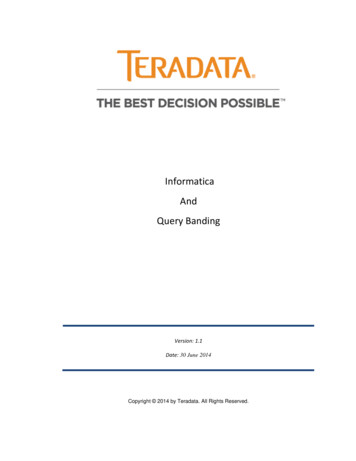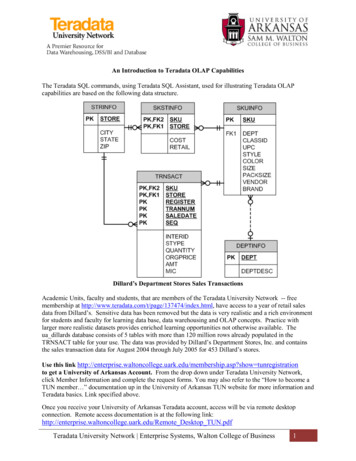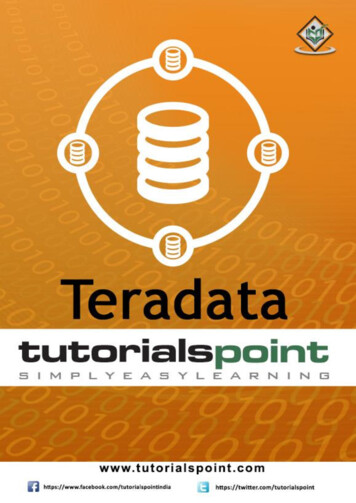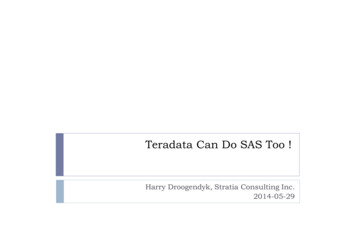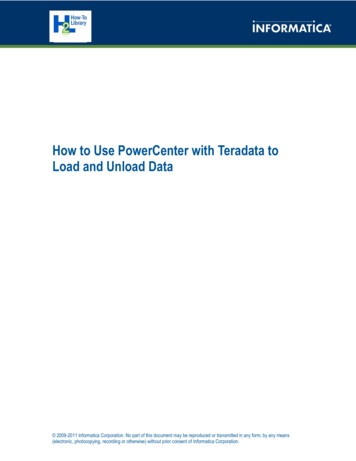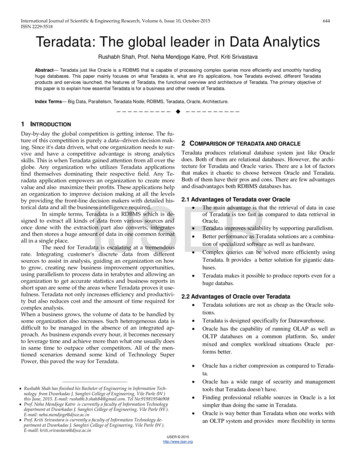
Transcription
International Journal of Scientific & Engineering Research, Volume 6, Issue 10, October-2015ISSN 2229-5518644Teradata: The global leader in Data AnalyticsRushabh Shah, Prof. Neha Mendjoge Katre, Prof. Kriti SrivastavaAbstract— Teradata just like Oracle is a RDBMS that is capable of processing complex queries more efficiently and smoothly handlinghuge databases. This paper mainly focuses on what Teradata is, what are it's applications, how Teradata evolved, different Teradataproducts and services launched, the features of Teradata, the functional overview and architecture of Teradata. The primary objective ofthis paper is to explain how essential Teradata is for a business and other needs of Teradata.Index Terms— Big Data, Parallelism, Teradata Node, RDBMS, Teradata, Oracle, Architecture.—————————— ——————————1 INTRODUCTIONDay-by-day the global competition is getting intense. The future of this competition is purely a data--driven decision making. Since it's data driven, what one organization needs to survive and have a competitive advantage is strong analyticsskills. This is when Teradata gained attention from all over theglobe. Any organization who utilizes Teradata applicationsfind themselves dominating their respective field. Any Teradata application empowers an organization to create morevalue and also maximize their profits. These applications helpan organization to improve decision making at all the levelsby providing the front-line decision makers with detailed historical data and all the business intelligence required.In simple terms, Teradata is a RDBMS which is designed to extract all kinds of data from various sources andonce done with the extraction part also converts, integratesand then stores a huge amount of data in one common formatall in a single place.The need for Teradata is escalating at a tremendousrate. Integrating customer's discrete data from differentsources to assist in analysis, guiding an organization on howto grow, creating new business improvement opportunities,using parallelism to process data in terabytes and allowing anorganization to get accurate statistics and business reports inshort span are some of the areas where Teradata proves it usefulness. Teradata not only increases efficiency and productivity but also reduces cost and the amount of time required forcomplex analysis.When a business grows, the volume of data to be handled bysome organization also increases. Such heterogeneous data isdifficult to be managed in the absence of an integrated approach. As business expands every hour, it becomes necessaryto leverage time and achieve more than what one usually doesin same time to outpace other competitors. All of the mentioned scenarios demand some kind of Technology SuperPower, this paved the way for Teradata.2 COMPARISON OF TERADATA AND ORACLETeradata produces relational database system just like Oracledoes. Both of them are relational databases. However, the architecture for Teradata and Oracle varies. There are a lot of factorsthat makes it chaotic to choose between Oracle and Teradata.Both of them have their pros and cons. There are few advantagesand disadvantages both RDBMS databases has.IJSER2.1 Advantages of Teradata over Oracle The main advantage is that the retrieval of data in caseof Teradata is too fast as compared to data retrieval inOracle. Teradata improves scalability by supporting parallelism. Better performance as Teradata solutions are a combination of specialized software as well as hardware. Complex queries can be solved more efficiently usingTeradata. It provides a better solution for gigantic databases. Teradata makes it possible to produce reports even for ahuge databas.2.2 Advantages of Oracle over Teradata Teradata solutions are not as cheap as the Oracle solutions. Teradata is designed specifically for Datawarehouse. Oracle has the capability of running OLAP as well asOLTP databases on a common platform. So, undermixed and complex workload situations Oracle performs better. ———————————————— Rushabh Shah has finished his Bachelor of Engineering in Information Technology from Dwarkadas J. Sanghvi College of Engineering, Vile Parle (W )this June, 2015. E-mail: rushabh.b.shah84@gmail.com. Tel No:919819546908 Prof. Neha Mendjoge Katre is currently a faculty of Information Technologydepartment at Dwarkadas J. Sanghvi College of Engineering, Vile Parle (W ).E-mail: neha.mendjoge@djsce.ac.in Prof. Kriti Srivastava is currently a faculty of Information Technology department at Dwarkadas J. Sanghvi College of Engineering, Vile Parle (W ).E-maill: kriti.srivastava@djsce.ac.in IJSER 2015http://www.ijser.orgOracle has a richer compression as compared to Teradata.Oracle has a wide range of security and managementtools that Teradata doesn't have.Finding professional reliable sources in Oracle is a lotsimpler than doing the same in Teradata.Oracle is way better than Teradata when one works withan OLTP system and provides more flexibility in terms
International Journal of Scientific & Engineering Research, Volume 6, Issue 10, October-2015ISSN 2229-5518 of programming permitting the use of functions, procedures and packages.There is an issues of dirty reads with Teradata, whereasno such issue in Oracle.Teradata Director Program ( TDP ): It performs session balancing across multiple PEs and notifies if there occurs anyfailure like application failure or Teradata restart. Also, it doesfew other tasks such as logging, verification, recovery, restart,security.3 ARCHITECTUREThough Teradata has a lot of features and performs a tremendous number of tasks, Teradata functions in a simple way. Thefunctioning of Teradata is a process that consists of the following components: 645Micro Teradata Director Program ( MTDP ): It is similar toTDP in few ways. It performs some of the functions carried onby TDP which includes session management, but not sessionbalancing.Micro Operating System Interface ( MOSI ): It mainly pro-Channel-Attached SystemNetwork-Attached SystemTeradata NodeDisk Arrayvides network protocol independent interface and operatingsystem.Out of all the components, Teradata Node is the mostimportant component as this is the component where the entire Teradata Architecture is carried on. A single node is a (SMP ) Symmetric Multi-Processor. All the essential functionalities Teradata is supposed to perform takes place withinIJSERTeradata Node. Teradata Node explains the entire architectureof Teradata. It consists of applications, LAN gateway andchannel-driver software all of which runs as processes .The main sub-components of a Teradata Node are: Parsing Engine.BYNET.AMP.Figure 1: Functional OverviewIt can have multiple client applications as Teradata Node cansupport parallelism and expandability. These client side applications are connected to the Teradata Node either throughsome channel or LAN. If the application is on a ChannelAttached System then it is connected to the Node by means ofsome channel and if the application is on Network-AttachedSystem, the system is connected to the Node by LAN.Channel-Attached System consists of: CLI and TDP and Network-Attached System consists of: CLI, MTDP and MOSI.Figure 2: Teradata NodeCall Level Interface ( CLI ): It performs logon and logoff functions. It is basically a library of routines for blocking and un-AMPs and PEs are ( vprocs )virtual processors that run underblocking requests and responses to/from the RDBMS.the ( PDE ) Parallel Database Extension. AMPs are associatedwith ( vdisks )virtual disks via the disk controller.IJSER 2015http://www.ijser.org
International Journal of Scientific & Engineering Research, Volume 6, Issue 10, October-2015ISSN 2229-5518646"Shared-Nothing" Architecture. There can be multiple AMPsin a Teradata Node. AMP performs the following tasks:Figure 3: ArchitectureThe diagram shows the workflow of Teradata Node. Store and retrieve rows to and from the disks. Lock Management.Sort rows and aggregate columns. Join processing.Converts and formats output. Create answer sets for clients.Manage disk space. Special utility processing.Recovery processing.The first component in the Teradata Node is the Parsing En-And then the final component in the functioning of Teradatagine. Now Parsing Engine itself has 4 sub-components:is Disk Array. They are also know as array of Virtual disks as a Session ControlParserOptimizerDispatcherdisk array has multiple vdisks which forms an array of vdisks.There are multiple disk arrays depending on the number ofAMPs. Each AMP vproc is assigned to a vdisk. And individually each vdisk may contain 119GB of disk space. Each diskIJSERarray is assigned a rank.And it's main responsibility is to man-The Parsing Engine carries out the following tasks in the order: Manages individual sessions (up to 120 sessions) Parses and optimizes the SQL request made by the client.Dispatches the optimized plan to the AMPs.Also, converts ASCII to EBCDIC and vice versa ifneededSends back the answer set response to the client whomade the request. The next component after Parsing Engine is BYNET. It is adual redundant, fault tolerant bi-directional network that iscapable of enabling automatic reconfiguration after fault detection, automatic load balancing of message traffic as well asage and distribute parity and data.4 FEATURESTeradata is another RDBMS which is completely scalable. Created by Teradata Corp, it is largely used for managing bugoperations under the sector of data warehousing. Also, it hasthe ability to process a huge number of requests concurrentlyfrom multiple number of client applications. It's database system is dependent on a 'off-the-shelf symmetric multiprocessing technology that is in conjunction with communication networking. Teradata has a large number of features thatspeaks for it's significance.However, there are few salient features that make it to be theprimary choice for users. They are as follows:scalable bandwidth if needed.But mainly BYNET is responsible for the following tasks in theorder: Broadcasts, multicasts and point-to-point communications between nodes and virtual processors.Merging answer sets back to the PE.Makes Teradata parallelism possible.The 3rd sub-component is Access Module Processor( AMP ). It Full Scalability.Parallel efficiency. Ability to execute complicated queries with 256 joins atthe most. Allows parallelism and load distribution by sharing itamong various users.Other features of Teradata are: basically performs all the tasks in parallel using Teradata'sIJSER 2015http://www.ijser.orgWorks in conjunction with SAS and allows an efficient,faster and easier usage of (FFS) Fee-for-service.
International Journal of Scientific & Engineering Research, Volume 6, Issue 10, October-2015ISSN 2229-5518 Automates the process of content-review by role in order to reduce time for message delivery and guaranteecompliance.Tracks spending from marketing concept across currencies globally using only one solution.Designs, executes a large number of campaigns acrosstraditional as well as digital channels. Also, assesses thebehavior of any customer's response in real time withthe assistance of some channel.With the help of integrated data, Teradata improves theimpact of marketing campaigns and for an organizationsimplifies adapting to the variations in the market.647Another important feature apart from parallelism is expandability. Teradata is linearly expandable. There is some relationbetween different components in the Teradata architecturethat explains how is it possible to scale and expand. Components may be added as requirements grow without degradingof performance.In the diagram, if we double the number of AMPs and keepthe number of users to be same, the performance will alsodouble. However, if we double the number of AMPs and double the number of users as well, the performance remains thesame,The above scenario states that it is possible to expandTeradata Parallelism:as per the requirement and also proves that the expansionTeradata performs all tasks in parallel to provide exceptionaldoesn't degrade the performance in any scenario.performance. Since, this is a feature that has helped Teradataevolved exponentially it is necessary to have a brief idea about5 PRODUCTS AND SERVICEShow it works. The entire process of parallelism is depicted as :Data is ruling the market and more importantly controllingthe market. Getting precise results demands better marketingstrategies. As the world gets bigger, the data too gets bigger.This is when Teradata comes picture. More the amount of datamore is the need of Teradata. There are various products thatcome under the umbrella of Teradata family. Few of them areTeradata Database, Data Warehouse and a set of analytic tools.This Teradata family help numerous small-scale, large-scalecompanies to analyze the massive quantity of data that hasbeen unified from various sources and throws light on thethings that are of higher significance in the world.IJSERFigure 4: ParallelismIn the above figure, .For each PE handling sessions upto 120 is manageable.Every session has the ability to control multiple Requests.All the message activities are handled by the BYNET inparallel.Similarly each AMP is capable of performing 80 tasksin parallel.All AMPs work in parallel to service any request.Each AMP can work on several requests in parallel.Teradata Expandibility:Also, Teradata Corporation is a leading analytic datasolutions company that concentrates more on big data analytics, integrating data warehousing as well as business applications. Various services and products of Teradata provides therequired insight to bolster organizations in making the bestsuitable decisions.The need for Teradata shooted on such a large scale that thecompany Teradata kept on acquiring several renowned companies like Aprimo, Aster Data Systems, Hadapt etc. after it'sintroduction. By 2010, Teradata was associated with 'Big Data'.Due to
Teradata makes it possible to produce reports even for a huge databas. 2.2 Advantages of Oracle over Teradata Teradata solutions are not as cheap as the Oracle solu-tions. Teradata is designed specifically for Datawarehouse. Oracle has the capability of running OLAP as well as OLTP databases on a common platform. So, under

